Development of web applications has almost become a trivial task. Modern frameworks like Rails can scaffold a complete application in minutes, and with AI assistance, even beginners can build functional sites. But this convenience comes with a trade-off: we rarely think about what’s happening beneath the abstraction layers.
What if we stripped away all those layers? What if we built a web application using nothing but raw x64 Assembly? This tutorial guides you in building a minimal, complete web application that computes the sum of first n natural numbers.
Why Assembly?
Most web applications today use Python, NodeJS, Java, C#, PHP, or Ruby, which provide a plethora of functionalities built-in that makes webdev easier. But it comes at a cost — by hiding a lot of internal workings, such as System Calls, Memory Management, etc… that are crucial to understand the performance of the web application.
Assembly language isn’t as scary as it seems! In fact, it helps one to understand how the computer works internally. So, I made this project, as a Proof of concept, to demonstrate how one can write web applications in (virtually) any programming language.
This project uses CGI protocol to create the web app.
What is CGI?
CGI (Common Gateway Interface) is one of the oldest and simplest protocols that enables dynamic, server-side controlled web applications. It works as follows:
Request from user: The User makes a request to the CGI script (e.g.,
http://example.com/cgi-bin/hello.cgi) on the web server. The web server, when configured properly, recognizes it as a CGI request (typically by the/cgi-bin/path or.cgiextension)The server runs the script: The web server, based on the information from the HTTP request (query parameters, headers, method, etc…) runs the actual target script and provide those information via:
- Environment variables (such as
QUERY_STRING,CONTENT_LENGTH, etc…) - Standard input (stdin) for POST data
- Environment variables (such as
The output of the executed program is collected and given as the response for the request
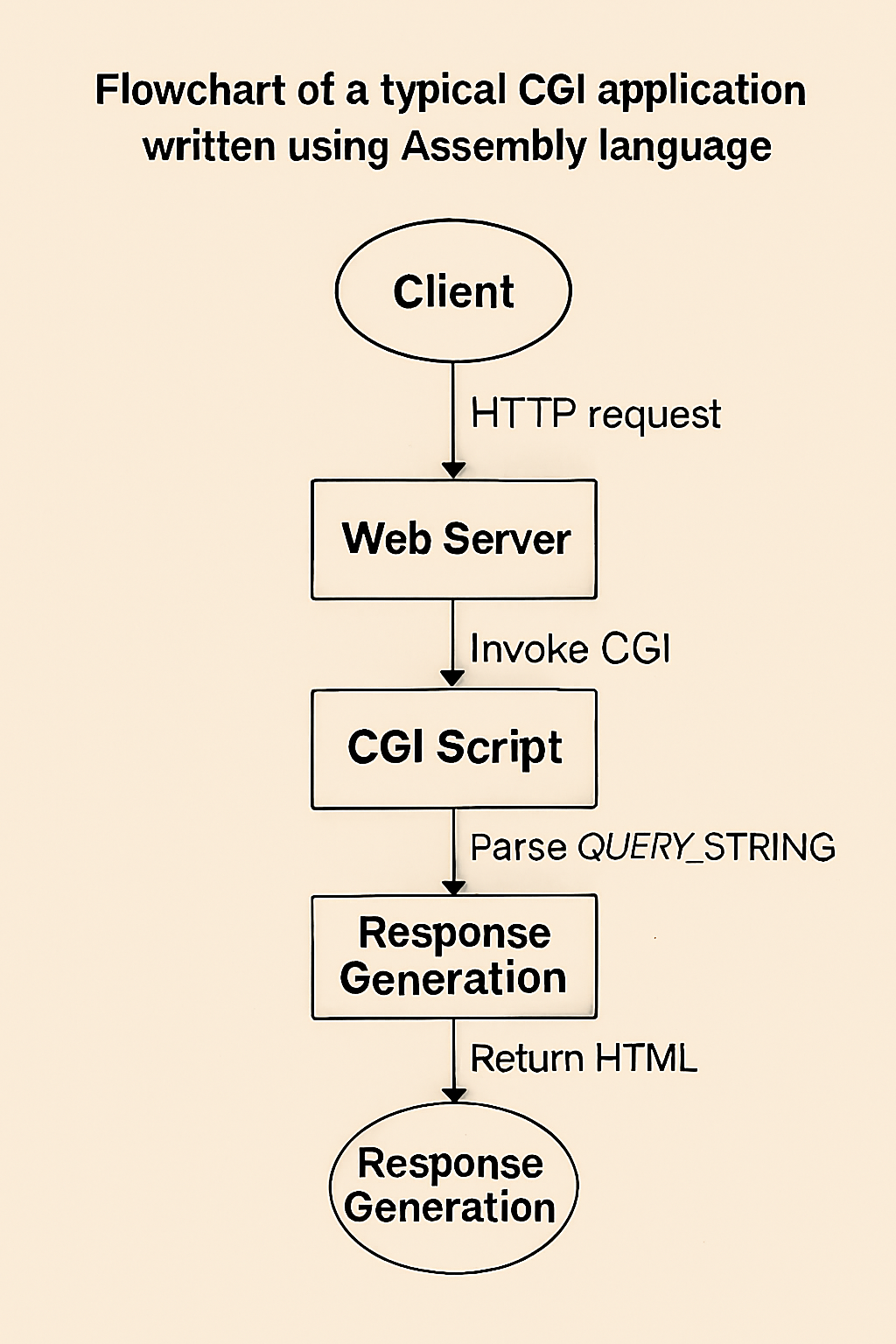
So, this workflow shows us that any programming language that supports reading of environment variables, and basic I/O can be used to write web application.
Prerequisites
To make this Web app, you’ll need the following:
- A Windows machine (this can be adapted to run on Linux, too.)
- An assembler (we’ll use NASM)
- GCC (for stdlib functions)
- Python (< 3.15, for CGI server)
- make, for building the code
Note that I’m using the NASM assembler, since it is a widely used flavour of assembly. But this can be written in any assembler.
Python is required to host up the CGI scripts. The built-in web server of python supports it via the --cgi flag. You’re free to use any web server (like Apache, NGNIX, etc…) that has support for CGI scripts.
This tutorial assumes the reader to have basic knowledge on HTML, Assembly language instructions and C standard library functions.
Setup
Start the project by creating a folder under your projects directory. Note that the > symbol in the following snippets denotes the command prompt, and do not include it while typing it out at your terminal.
> mkdir asm-cgi
> cd asm-cgiWe would also require a cgi-bin directory, for the web server to recognize CGI scripts.
> mkdir cgi-binWe’ll be using a Makefile to simplify the build process.
ASM = nasm
ASMFLAGS = -f win64
CC = gcc
CFLAGS =
SRC_DIR = cgi-bin
OUT_DIR = cgi-bin
ASM_FILES := $(wildcard $(SRC_DIR)/*.asm)
CGI_FILES := $(ASM_FILES:$(SRC_DIR)/%.asm=$(OUT_DIR)/%.cgi)
OBJ_FILES := $(ASM_FILES:$(SRC_DIR)/%.asm=%.obj)
all: $(CGI_FILES)
$(OUT_DIR)/%.cgi: $(SRC_DIR)/%.asm
$(ASM) $(ASMFLAGS) $< -o $*.obj
$(CC) $*.obj -o $@
del /Q $*.obj
clean:
del /Q $(SRC_DIR)\*.obj $(OUT_DIR)\*.cgi
run: all
python -m http.server --cgi
.PHONY: all cleanCreating the interface
Let’s start by creating a simple form to get inputs and pass to the CGI script. Create index.html in the root folder of project.
<!DOCTYPE html>
<html lang="en">
<head>
<title>ASM CGI</title>
</head>
<body>
<h1>Web app using Assembly</h1>
<p>This is a simple web app using Assembly as CGI script.</p>
<br>
<h2>Example using GET:</h2>
<form action="/cgi-bin/hello.cgi" method="get">
<label for="name">Enter your name:</label>
<input type="text" id="name" name="name">
<input type="submit" value="Submit">
</form>
</body>
</html>This is fairly a simple HTML form, but it uses GET method to send the request to the server. A Typical request made to the server looks like
http://localhost:8000/cgi-bin/hello.cgi?name=<Your Name>where <Your Name> refers to the name that you’ve given as input in the form.
The CGI script will be called with an Environment Variable, named QUERY_STRING and it will contain the string "name=<Your Name>"
Creating our Assembly Language Template
Let’s start writing the CGI script in assembly. Create hello.asm under the cgi-bin directory:
bits 64
global main
extern printf, getenv, sscanf
section .data
respHdr db `Content-type: text/html\n\n`, 0
htmlTemp db "<html><head>"
db "<title>Hello, Web</title>"
db "</head><body>"
db "<h1>Hello %s</h1>"
db "This script is written using Assembly</html>", 0
queryStr db "QUERY_STRING", 0
fmtStr db "name=%s", 0
section .bss
name resb 32We start by externing the required C Standard library functions and making our main function global. We also declare the necessary strings and variables in our program beforehand that has to be used.
The "Content-type: text/html\n\n" forms the HTML response header, and it is necessary for the client to recognize this as a proper HTML file. NASM allows C-Style escape sequences when strings are enclosed in backticks(`)
section .text
main: sub rsp, 56
; ... Main Program Logic goes here ...
add rsp, 56
xor rax, rax
retThis is our template for main function. We start by subtracting 56 from RSP register (for allocating shadow space) as per requirements of Windows ABI(note that stack always grows downwards in x86_64). We deallocate it by add 56 to RSP and return from the function by setting RAX to zero.
A Brief Detour: the Windows ABI
According to the Windows ABI specification, the first 4 integer (or pointer) arguments are passed onto registers
RCXRDXR8R9
Further arguments are pushed onto the stack, in right-to-left order. The return value is placed in RAX register.
Let’s say you want to make this equivalent C function call
printf("Hello, %s! Your age is %d", name, age)(Assuming variables char* name and int age exists)
You would need to call in assembly as follows:
section .data
fmt db "Hello, %s! Your age is %d", 0
section .text
main: mov rcx, fmt ; Pointer to Format string
mov rdx, name ; Pointer to Name
mov r8, [age] ; Value of age, from pointer age
call printfHandling GET Requests
Now that we have idea about function calls in assembly, handling GET Requests look as follows:
1 section .text
2main: sub rsp, 56
3
4 ; printf(respHdr)
5 mov rcx, respHdr
6 call printf
7
8 ; RAX = getenv(queryStr)
9 mov rcx, queryStr
10 call getenv
11
12 ; sscanf(RAX, fmtStr, name)
13 mov rcx, rax
14 mov rdx, fmtStr
15 mov r8, name
16 call sscanf
17
18 ; printf(htmlTemp, name)
19 mov rcx, htmlTemp
20 mov rdx, name
21 call printf
22
23 add rsp, 56
24
25 xor rax, rax
26 retThis just prints the HTTP Response Header, reads the name from the QUERY_STRING environment variable, and prints the predefined template.
Handling POST requests
Using forms with GET requests are fine, but they pose a major problem, they echo the input in the URL. Sometimes, we may need to create forms whose actions are permanent and non-reversible and a suitable method for it is POST.
As per CGI specification, POST request data is placed in the stdin and the total length of the input data is placed in the CONTENT_LENGTH environment variable.
Let’s try writing one. Create another file named sum_to_n.asm which gets a number via POST request and prints the sum of first n natural numbers.
bits 64
default rel
global main
extern printf, getenv, sprintf, scanf, atoi
section .data
respHdr db `Content-type: text/html\n\n`, 0
htmlTemp db "<html><head>"
db "<title>Sum Till N</title>"
db "</head><body>"
db "<h1>The sum from 1 to %d = %d</h1></body></html>", 0
clenStr db "CONTENT_LENGTH", 0
tempFmtStr db "n=%%%dd", 0
section .bss
inputFmtStr resb 7
n resq 1As before, we extern some built-in functions and declare template strings along with a new, strange looking tempFmtStr variable (will be discussed in a minute).
We allocate 7 bytes for the inputFmtStr since the final generated format string looks as follows:
"%<n>d", 0The remaining 4 bytes are allocated for varying <n>.
section .text
main: sub rsp, 56
mov rcx, respHdr
call printf
mov rcx, clenStr
call getenvLet’s go over line by line:
- The first function call is for
printfto print the response header. - The second function call is for
getenvto get the length of input (i.e., thePOSTrequest)
mov rcx, rax
call atoi
sub rax, 2This function call is made to atoi, to convert the CONTENT_LENGTH value to a int. Since RAX contains the result of getenv, we use it directly. We subtract 2 from RAX to account for the fact that stdin contains the request as follows:
n=<Your Input>Where <Your Input> refers to the value of n submitted to the CGI script.
mov rcx, inputFmtStr
mov rdx, tempFmtStr
mov r8, rax
call sprintf
mov rcx, inputFmtStr
mov rdx, n
call scanfHere comes the role of tempFmtStr. Unlike printf, scanf (or sscanf) doesn’t support parametric passing of content length via "*" symbol. Hence, we use a template format string to generate the original format string that has to passed to scanf.
mov r8, [n]
inc r8
imul r8, [n]
shr r8, 1This is our main logic to calculate the sum of first n natural numbers. Instead of writing a manual loop, we use the mathematical formula:
$$ S_n = \frac{n(n+1)}{2} $$
Which is achieved via the imul instruction. Since the division is by 2 and by the rule, $n(n+1)$ is always divisible by 2 $\forall n \in \mathbb{N}$, we use the Shift Right(shr) operation by 1.
mov rcx, htmlTemp
mov rdx, [n]
; r8 already has the sum
call printf
add rsp, 56
xor rax, rax
retFinally we print the values and exit successfully. Note that we stored our result in R8 register intentionally so that an extra mov instruction isn’t required at the time of function call.
For the server to handle the POST request, let’s add another form to our index.html
<!DOCTYPE html>
<!--Omitted for Brevity-->
</form>
<h2>Example using POST:</h2>
<form action="cgi-bin/sum_to_n.cgi" method="post">
<label for="str">Enter number till which to calculate sum:</label>
<input type="text" id="n" name="n">
<input type="submit" value="Submit">
</form>
</body>
</html>Running the Server
Let’s compile the .asm files
> nasm -f win64 cgi-bin/hello.asm -o hello.obj
> gcc hello.obj -o cgi-bin/hello.cgi
> del /Q hello.obj
> nasm -f win64 cgi-bin/sum_to_n.asm -o sum_to_n.obj
> gcc sum_to_n.obj -o cgi-bin/sum_to_n.cgi
> del /Q sum_to_n.objTo run the web server, we’ll use the python’s built-in HTTP server.
> python -m http.server --cgiNote that you need to be outside the cgi-bin directory to access the CGI scripts. Try filling the first form to get greeting.
If you submit the second form, you’ll get the result of sum. Here’s the sample output that I got: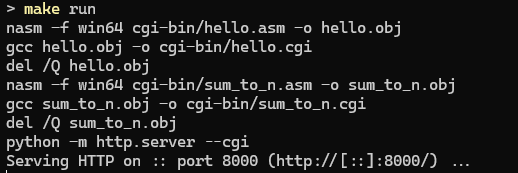
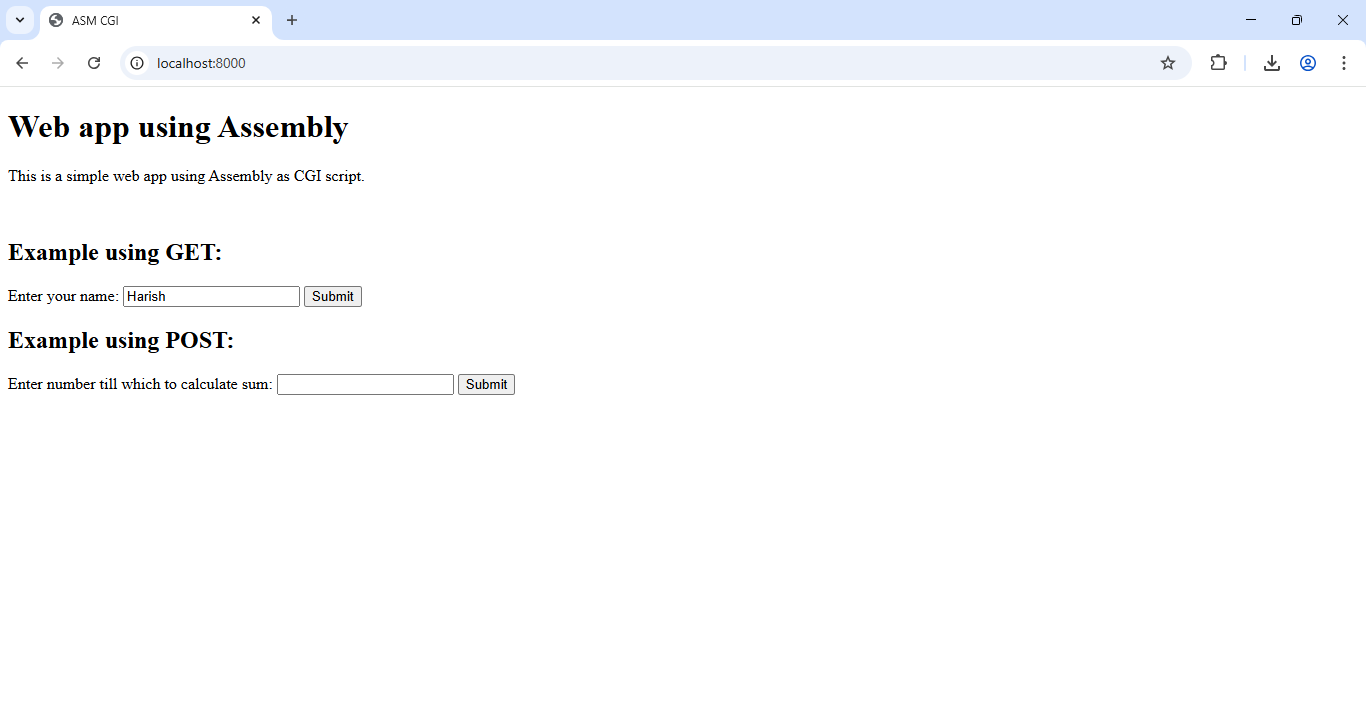
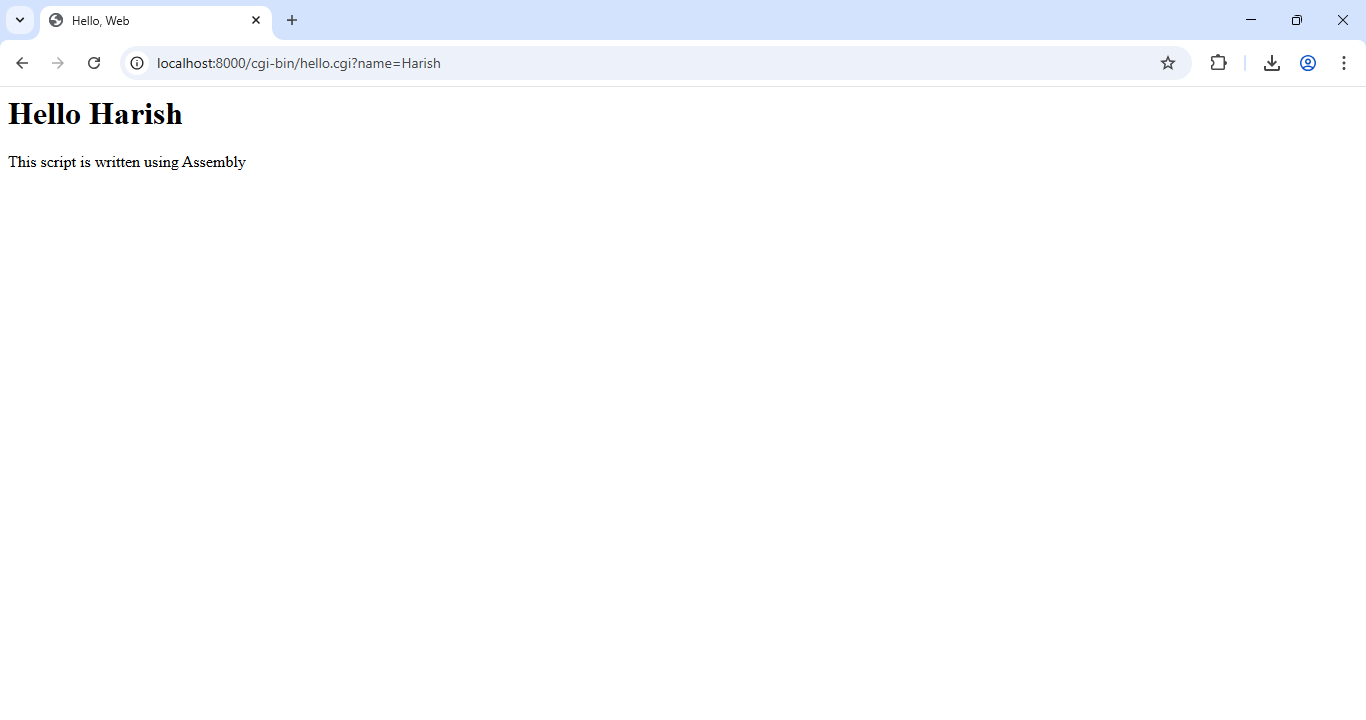
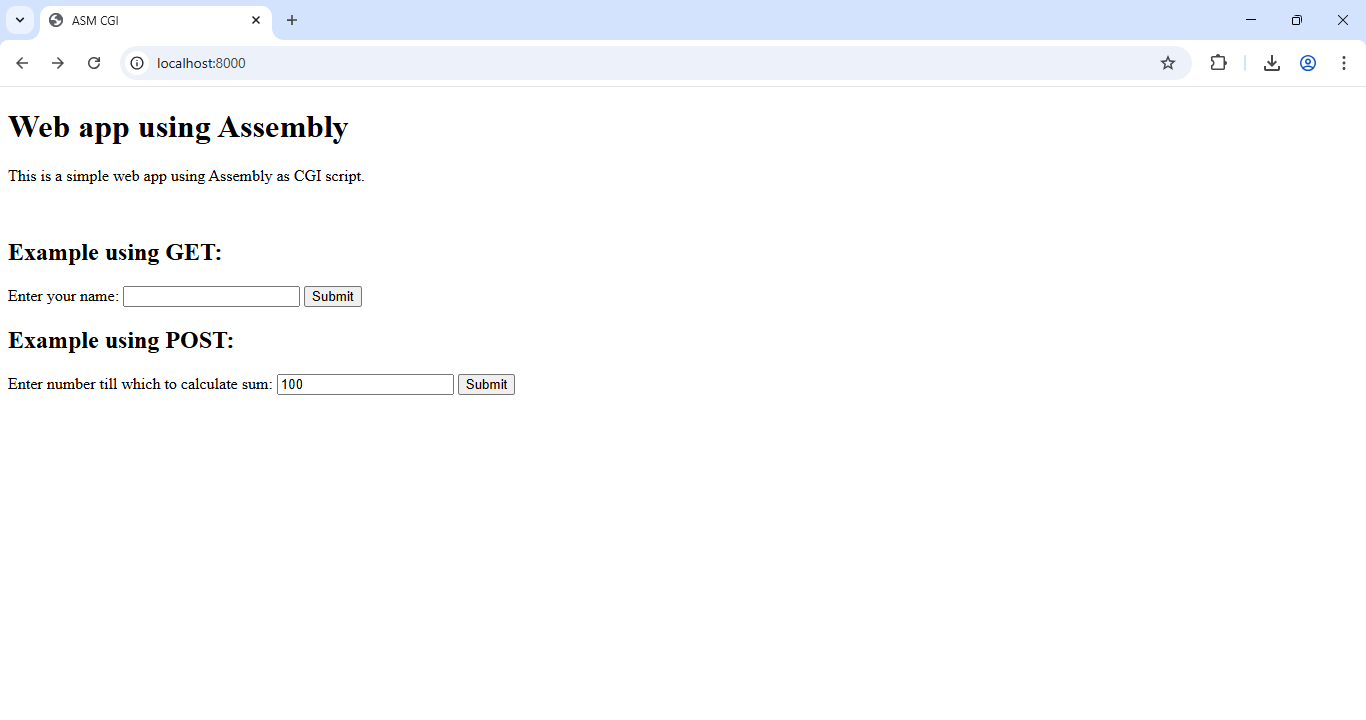
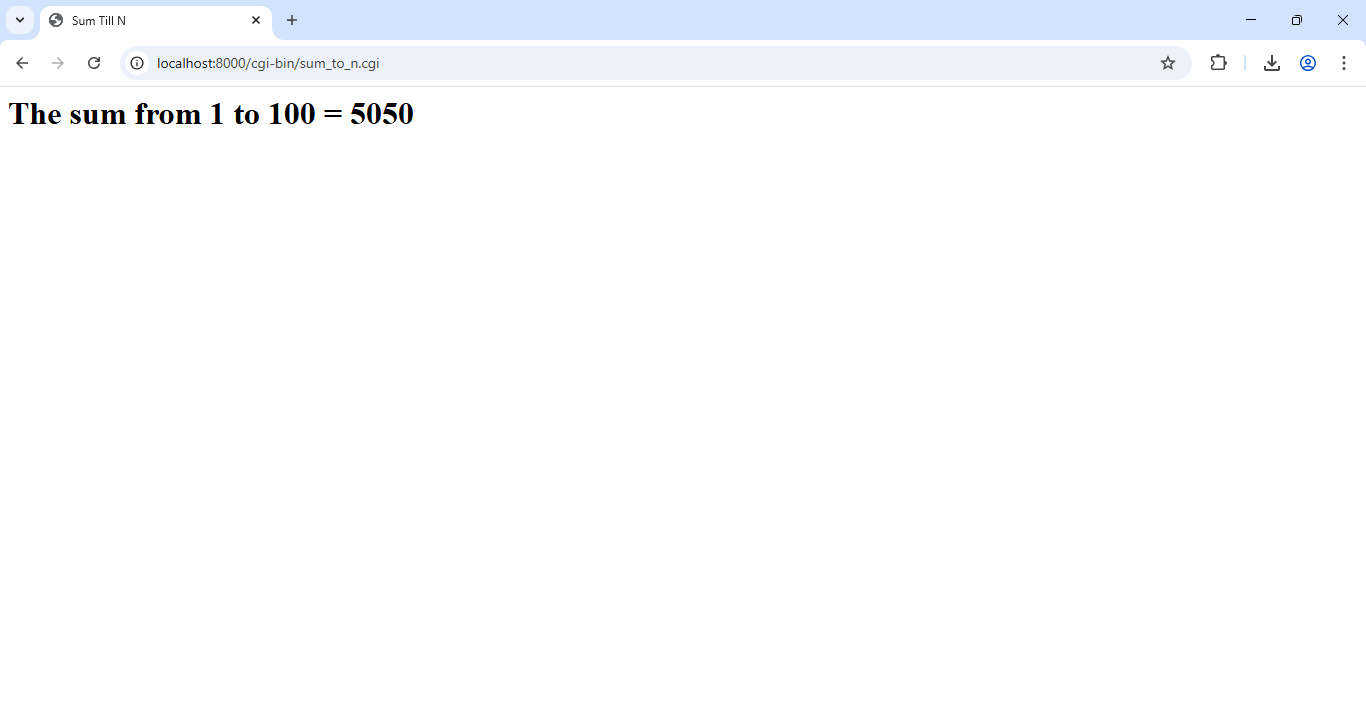
Conclusion
With this, we’ve accomplished writing a minimal, yet functional web application using raw x64 Windows assembly. You can check out the source of this project here . If you need to suggest any changes, feel free to create an issue at my repo.
Thanks for Reading!
